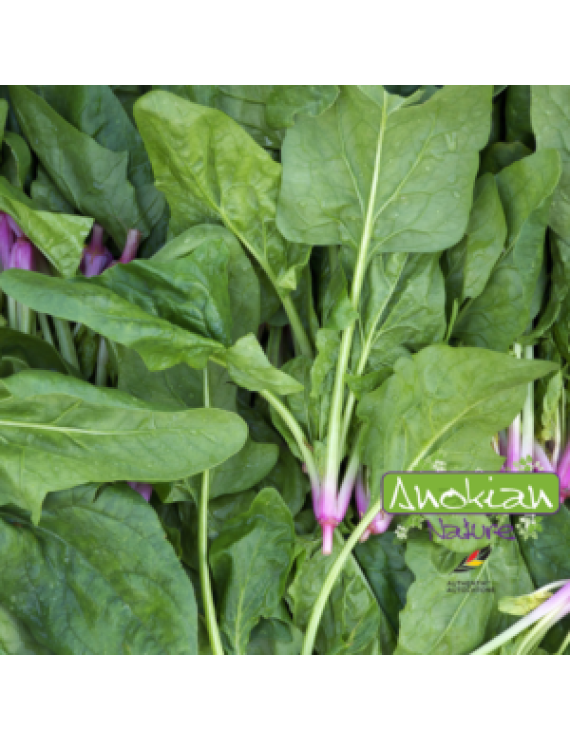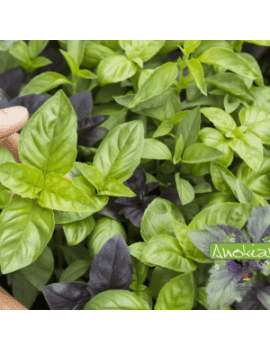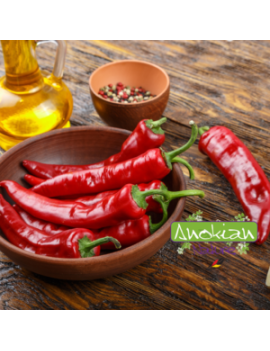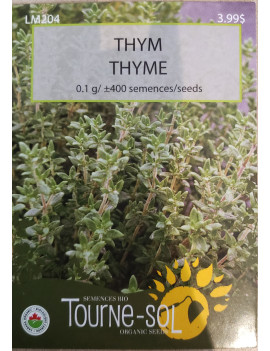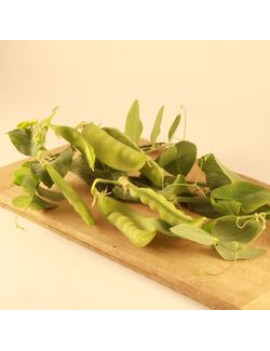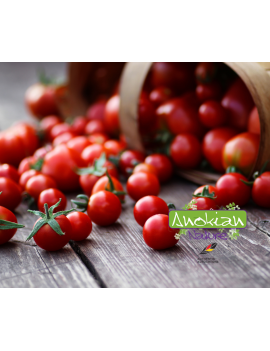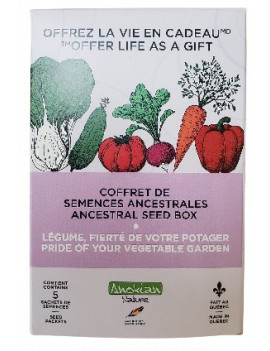Semences Épinard Japonais (Anokian)
Distance parcourue : 500 Km en moyenne
-
3.99 $ + taxes
Description
Sans OGM
Résistant au froid
Semence non traitée
Sans pesticide|
Tout Plant comestible
Pollinisation libre
Enveloppe compostable
Histoire:
Les épinards Japonais se forment en rosettes qui produisent des tiges allongées, dressées et minces avec des feuilles pointues à plusieurs lobes. Les feuilles vert foncé ont 2 à 3 lobes effilés et sont d’apparence uniforme, présentant des bords semi-dentelés.
Les feuilles sont également lisses, épaisses, larges et souples, avec des veines profondes sur toute la surface.
Les tiges sont vert , longues, droites et étroites avec une nature lisse et ferme. c’est épinards ont une consistance croustillante et succulente.
Les tiges sont également comestibles et ont une texture croquante, légèrement fibreuse et moelleuse. Les légumes verts ont une saveur douce, végétale lorsqu’ils sont crus et développent une sensation en bouche tendre et douce avec des nuances de noisette lorsqu’ils sont cuits. Les racines sont comestibles et rosé délicieuse a souhait:)
De nombreuses variétés d’épinards ont été créées en Chine et au Japon et ont été vendues pour la culture commerciale et l’utilisation dans les jardins familiaux.
cultivés de manière sélective comme une variété capable de résister à des températures extrêmes autant à la chaleur et même au froid sans boulonner.
Aujourd’hui, les variétés d’épinards Japonais sont cultivées et sont produites à plus petite échelle que les autres cultivars d’épinards.
Les légumes verts frais sont offerts dans les marchés de producteurs, les détaillants spécialisés et certains épiciers haute gamme en chine et au japon.
Je cultive cette variété depuis plusieurs années, car j’ai reçu les semences d’une famille venant du Japon qui cultive cette variété depuis plusieurs générations.
Donc j’ai décidé de le cultiver ici et pour tester cette variété extraordinaire.
Ce cultivar je la cultive sur toute nos saisons et même pendant l’hiver.
c’est une variété qui repousse donc, si vous prenez les feuilles a l’extérieur et que vous prenez ceux qui commence a venir en fleur vous aurez des épinards pour une longue saison.
Souvent je fais mes semis au printemps a l’extérieur et je mange les même épinard jusqu’à la fin de l’été et je refais d’autre semis seulement vers le milieu de septembre.
Valeur nutritive et médicinale:
Les épinards Japonais sont une source de calcium pour renforcer les os et les dents, de vitamine C pour renforcer le système immunitaire
et réduire l’inflammation, et de vitamine K pour accélérer la cicatrisation des plaies.
La tige vertes et les racines roses fournissent également de la vitamine A pour maintenir le bon fonctionnement des organes, du fer pour développer
la protéine hémoglobine pour le transport de l’oxygène dans le sang, du folate pour produire des globules rouges sains et d’autres nutriments,
notamment le manganèse, les fibres, le potassium, le magnésium, le cuivre et le zinc. Ils sont appréciés pour contenir des propriétés anti-inflammatoires
et des antioxydants pour protéger les cellules contre les dommages causés par les radicaux libre.
On cuisine comment;
peuvent être mélangés à des salades, une préparation préférée pour mettre en valeur leur forme de feuille pointue et unique.
Les épinards Japonais, peuvent également être superposés dans des wraps, des sandwichs et des hamburgers, dans des smoothies, dans des trempettes ou mélangés
dans des bols à céréales.
En plus des préparations crues, ils résistent bien aux plats cuisinés et sont utilisés comme garniture sur la pizza ou flétris dans les pâtes.
Les feuilles épaisses peuvent être cuites à la vapeur ou sautées comme un simple plat d’accompagnement, cuites dans des plats à base d’œufs, notamment des omelettes, des quiches et des frittatas, ou hachées et farcies d’herbes, d’épices et d’autres garnitures dans les viandes. Les épinards Japonais peuvent également être mijotés dans des soupes, des currys et des ragoûts, utilisés comme lit de légumes verts cuits pour les fruits de mer, ou sautés avec des légumes comme côté nutritif.
Au Japon, ces cultivars sont utilisés dans le gomae, également orthographié goma-ae, une salade d’épinards. Gomae est composé d’épinards blanchis mélangés à une sauce de graines de sésame, de sucre, d’eau, de sauce soja et de poudre de dashi.Ils se marient bien avec des herbes comme le thym, le basilic, la livèche et l’aneth, des aromates comme l’ail, le gingembre, les échalotes et les oignons, les champignons, les pommes de terre, les navets, les fromages comme le parmesan, la feta et le cheddar, et les noix comme le pin, la noisette.
Les feuilles entières et non lavées se conservent 5 à 10 jours lorsqu’elles sont stockées dans un sac scellé entre des couches de serviettes en papier.
Les feuilles peuvent également être blanchies ou flétries et congelées pendant six mois, Voila;)
Nos semences sont vigoureuses, à pollinisation libre et adaptées au climat québécois
Espèce: Spinacia oleracear: Amaranthaceae
Semis: Début avril-mai (semis consécutif au 3 semaines jusqu’en septembre et en octobre dans une serre extérieur
ou serre froide cold frame pour avoir ce légume pendant l’hiver avec couverture de jardin dans la serre)
Semences: 3 semences par cellules ou pot en avril et mettre en terre vers le mileu mai
A partir de milieu mai , mettre les semences directement en terre.
Un petit truc de culture, mettre de l’ail, des oignons, des échalottes ou des poireaux entre chaque plants,
cela vous empêchera d’avoir des maladies:)
Profondeur de semis: 1-1.5 cm
Temps de germination: 5-12 jours
Sol: Pauvre, humifère, meuble et drainé
Endroit|Place : Soleil et tolère très bien l’ombre et le froid
Espacement entre les plants: 20-25cm
Hauteur à maturité 35-45cm
Maturité| : 35-45 jours
Semence par enveloppe: +/- 150
Provenance : Mercier, QC, CANADA - 55 Km.
Sans OGM
Résistant au froid
Semence non traitée
Sans pesticide|
Tout Plant comestible
Pollinisation libre
Enveloppe compostable
Histoire:
Les épinards Japonais se forment en rosettes qui produisent des tiges allongées, dressées et minces avec des feuilles pointues à plusieurs lobes. Les feuilles vert foncé ont 2 à 3 lobes effilés et sont d’apparence uniforme, présentant des bords semi-dentelés.
Les feuilles sont également lisses, épaisses, larges et souples, avec des veines profondes sur toute la surface.
Les tiges sont vert , longues, droites et étroites avec une nature lisse et ferme. c’est épinards ont une consistance croustillante et succulente.
Les tiges sont également comestibles et ont une texture croquante, légèrement fibreuse et moelleuse. Les légumes verts ont une saveur douce, végétale lorsqu’ils sont crus et développent une sensation en bouche tendre et douce avec des nuances de noisette lorsqu’ils sont cuits. Les racines sont comestibles et rosé délicieuse a souhait:)
De nombreuses variétés d’épinards ont été créées en Chine et au Japon et ont été vendues pour la culture commerciale et l’utilisation dans les jardins familiaux.
cultivés de manière sélective comme une variété capable de résister à des températures extrêmes autant à la chaleur et même au froid sans boulonner.
Aujourd’hui, les variétés d’épinards Japonais sont cultivées et sont produites à plus petite échelle que les autres cultivars d’épinards.
Les légumes verts frais sont offerts dans les marchés de producteurs, les détaillants spécialisés et certains épiciers haute gamme en chine et au japon.
Je cultive cette variété depuis plusieurs années, car j’ai reçu les semences d’une famille venant du Japon qui cultive cette variété depuis plusieurs générations.
Donc j’ai décidé de le cultiver ici et pour tester cette variété extraordinaire.
Ce cultivar je la cultive sur toute nos saisons et même pendant l’hiver.
c’est une variété qui repousse donc, si vous prenez les feuilles a l’extérieur et que vous prenez ceux qui commence a venir en fleur vous aurez des épinards pour une longue saison.
Souvent je fais mes semis au printemps a l’extérieur et je mange les même épinard jusqu’à la fin de l’été et je refais d’autre semis seulement vers le milieu de septembre.
Valeur nutritive et médicinale:
Les épinards Japonais sont une source de calcium pour renforcer les os et les dents, de vitamine C pour renforcer le système immunitaire
et réduire l’inflammation, et de vitamine K pour accélérer la cicatrisation des plaies.
La tige vertes et les racines roses fournissent également de la vitamine A pour maintenir le bon fonctionnement des organes, du fer pour développer
la protéine hémoglobine pour le transport de l’oxygène dans le sang, du folate pour produire des globules rouges sains et d’autres nutriments,
notamment le manganèse, les fibres, le potassium, le magnésium, le cuivre et le zinc. Ils sont appréciés pour contenir des propriétés anti-inflammatoires
et des antioxydants pour protéger les cellules contre les dommages causés par les radicaux libre.
On cuisine comment;
peuvent être mélangés à des salades, une préparation préférée pour mettre en valeur leur forme de feuille pointue et unique.
Les épinards Japonais, peuvent également être superposés dans des wraps, des sandwichs et des hamburgers, dans des smoothies, dans des trempettes ou mélangés
dans des bols à céréales.
En plus des préparations crues, ils résistent bien aux plats cuisinés et sont utilisés comme garniture sur la pizza ou flétris dans les pâtes.
Les feuilles épaisses peuvent être cuites à la vapeur ou sautées comme un simple plat d’accompagnement, cuites dans des plats à base d’œufs, notamment des omelettes, des quiches et des frittatas, ou hachées et farcies d’herbes, d’épices et d’autres garnitures dans les viandes. Les épinards Japonais peuvent également être mijotés dans des soupes, des currys et des ragoûts, utilisés comme lit de légumes verts cuits pour les fruits de mer, ou sautés avec des légumes comme côté nutritif.
Au Japon, ces cultivars sont utilisés dans le gomae, également orthographié goma-ae, une salade d’épinards. Gomae est composé d’épinards blanchis mélangés à une sauce de graines de sésame, de sucre, d’eau, de sauce soja et de poudre de dashi.Ils se marient bien avec des herbes comme le thym, le basilic, la livèche et l’aneth, des aromates comme l’ail, le gingembre, les échalotes et les oignons, les champignons, les pommes de terre, les navets, les fromages comme le parmesan, la feta et le cheddar, et les noix comme le pin, la noisette.
Les feuilles entières et non lavées se conservent 5 à 10 jours lorsqu’elles sont stockées dans un sac scellé entre des couches de serviettes en papier.
Les feuilles peuvent également être blanchies ou flétries et congelées pendant six mois, Voila;)
Nos semences sont vigoureuses, à pollinisation libre et adaptées au climat québécois
Espèce: Spinacia oleracear: Amaranthaceae
Semis: Début avril-mai (semis consécutif au 3 semaines jusqu’en septembre et en octobre dans une serre extérieur
ou serre froide cold frame pour avoir ce légume pendant l’hiver avec couverture de jardin dans la serre)
Semences: 3 semences par cellules ou pot en avril et mettre en terre vers le mileu mai
A partir de milieu mai , mettre les semences directement en terre.
Un petit truc de culture, mettre de l’ail, des oignons, des échalottes ou des poireaux entre chaque plants,
cela vous empêchera d’avoir des maladies:)
Profondeur de semis: 1-1.5 cm
Temps de germination: 5-12 jours
Sol: Pauvre, humifère, meuble et drainé
Endroit|Place : Soleil et tolère très bien l’ombre et le froid
Espacement entre les plants: 20-25cm
Hauteur à maturité 35-45cm
Maturité| : 35-45 jours
Semence par enveloppe: +/- 150
Provenance : Mercier, QC, CANADA - 55 Km.

Mots clés: semence

